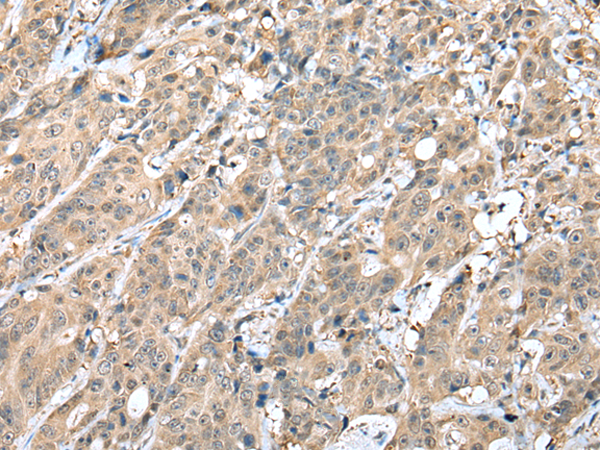

| WB | 咨询技术 | Human,Mouse,Rat |
| IF | 咨询技术 | Human,Mouse,Rat |
| IHC | 1/30-1/150 | Human,Mouse,Rat |
| ICC | 技术咨询 | Human,Mouse,Rat |
| FCM | 咨询技术 | Human,Mouse,Rat |
| Elisa | 1/5000-1/10000 | Human,Mouse,Rat |
| Aliases | HIF1; MOP1; PASD8; HIF-1A; bHLHe78; HIF-1alpha; HIF1-ALPHA |
| Host/Isotype | Rabbit IgG |
| Antibody Type | Primary antibody |
| Storage | Store at 4°C short term. Aliquot and store at -20°C long term. Avoid freeze/thaw cycles. |
| Species Reactivity | Human, Mouse |
| Immunogen | Fusion protein of human HIF1A |
| Formulation | Purified antibody in PBS with 0.05% sodium azide and 50% glycerol. |
+ +
以下是关于HIF1A抗体的3篇参考文献及其摘要概括:
---
1. **"Hypoxia-inducible nuclear factors bind to an enhancer element located 3' to the human erythropoietin gene"**
- **作者**: Semenza, G.L., et al.
- **摘要**: 该研究首次克隆并鉴定了HIF-1α蛋白,通过制备多克隆抗体验证了其在低氧条件下与促红细胞生成素(EPO)基因增强子的结合,为HIF-1α在缺氧反应中的核心作用奠定基础。
2. **"The tumour suppressor protein VHL targets hypoxia-inducible factors for oxygen-dependent proteolysis"**
- **作者**: Maxwell, P.H., et al.
- **摘要**: 研究揭示了VHL蛋白通过泛素-蛋白酶体途径调控HIF-1α稳定性的机制,利用特异性抗体在Western blot中证明常氧条件下HIF-1α的快速降解及其低氧依赖性积累。
3. **"HIF-1: mediator of physiological and pathophysiological responses to hypoxia"**
- **作者**: Semenza, G.L.
- **摘要**: 综述总结了HIF-1α在肿瘤、缺血等病理生理过程中的作用,提及多种实验技术(如ChIP、免疫组化)中HIF1A抗体的应用,强调其作为低氧标志物的重要性。
---
如需更多应用细节,可补充评估抗体性能的方法学文献(如Ruan et al., 2015对商业抗体的比较研究)。
The hypoxia-inducible factor 1-alpha (HIF1A) antibody is a critical tool for studying cellular responses to low oxygen conditions. HIF1A, a subunit of the heterodimeric HIF-1 transcription factor, plays a central role in oxygen homeostasis by regulating genes involved in angiogenesis, glycolysis, and cell survival under hypoxia. Under normoxia, HIF1A is rapidly degraded via the proteasome after hydroxylation and von Hippel-Lindau (VHL)-mediated ubiquitination. During hypoxia, HIF1A stabilizes, dimerizes with HIF1B (ARNT), and binds hypoxia-response elements (HREs) to activate target genes like VEGF and EPO.
HIF1A antibodies are widely used in research to detect protein expression, localization, and activation dynamics in diseases such as cancer, ischemia, and inflammatory disorders. They enable techniques like Western blotting, immunohistochemistry (IHC), immunofluorescence (IF), and chromatin immunoprecipitation (ChIP). Specific clones (e.g., H1alpha67) target distinct epitopes, affecting sensitivity and cross-reactivity. Researchers also use phospho-specific antibodies to study post-translational modifications regulating HIF1A activity.
Commercial HIF1A antibodies vary in host species, clonality, and validation standards. Proper controls are essential due to potential cross-reactivity with HIF2A or HIF3A. These antibodies have advanced our understanding of tumor microenvironments, metabolic adaptation, and therapeutic targeting of hypoxia pathways. However, inconsistent results across studies highlight the need for rigorous antibody validation and standardized experimental conditions.
×